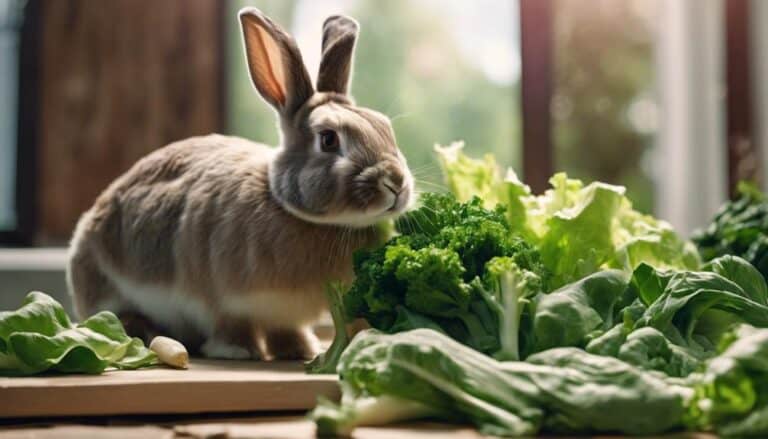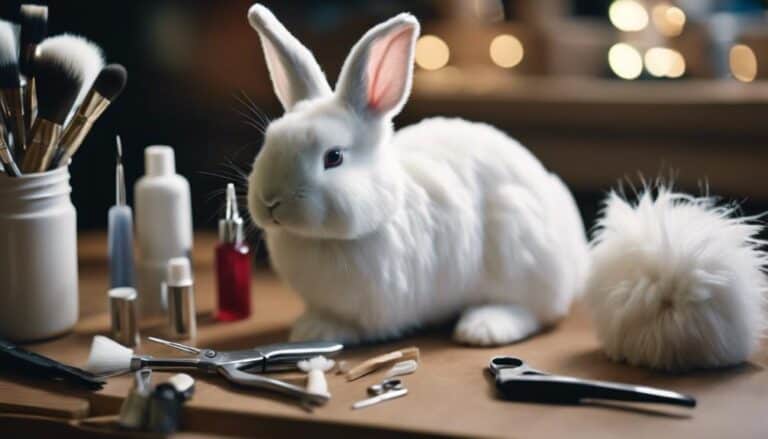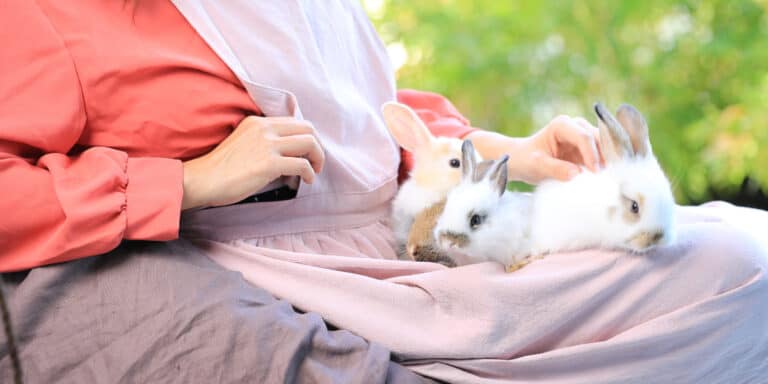Did you know that on average, a rabbit sheds its fur every 3 months? Understanding why bunnies shed can help you provide better care for your furry friend.
From diet adjustments to grooming techniques, there are important factors to ponder. By learning more about the shedding process and how to support your bunny during this time, you can guarantee their well-being and comfort.
Contents
- 1 Key Takeaways
- 2 Shedding Season: When Do Bunnies Shed?
- 3 Bunny's Appearance During Shedding
- 4 Managing Excessive Rabbit Shedding
- 5 Health Issues Related to Shedding
- 6 Hairball Prevention for Bunnies
- 7 Grooming Tips for Shedding Bunnies
- 8 Maintaining a Clean Environment During Shedding
- 9 Frequently Asked Questions
- 10 What Causes Bunnies to Shed and How Can I Care for Them During Shedding Season?
- 11 Conclusion
Key Takeaways
- Shedding occurs seasonally to regulate body temperature and maintain fur health.
- Regular grooming with appropriate tools prevents hair ingestion and maintains coat condition.
- Nutrient-rich diet and stress reduction help manage excessive shedding and promote overall well-being.
- Prompt veterinary attention for health issues, regular check-ups, and a stress-free environment are essential for bunny care.
Shedding Season: When Do Bunnies Shed?
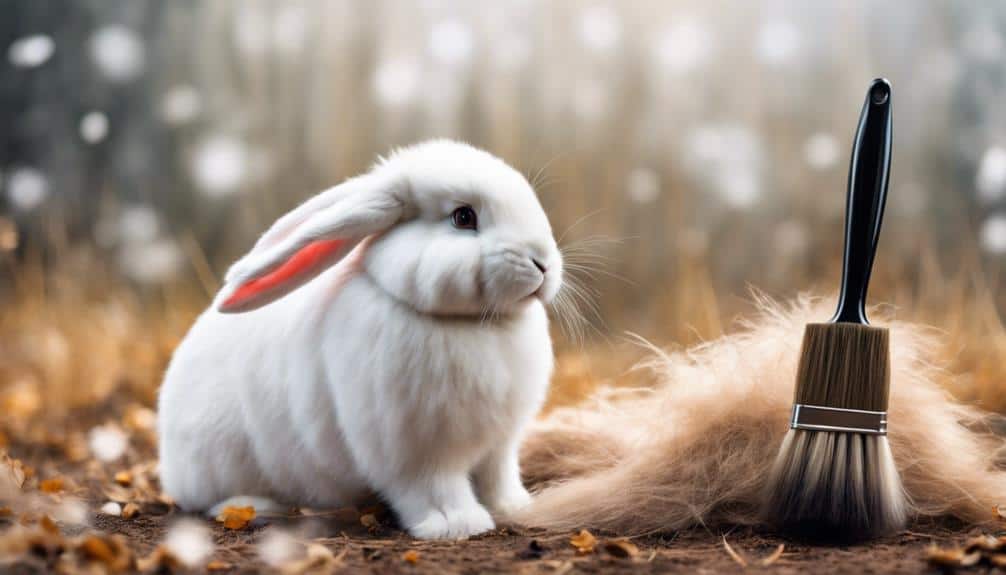
During shedding season, rabbits adapt to temperature changes by shedding their coat in a process that typically occurs in spring and fall. This shedding process starts at the head and progresses down the body of the bunny. Rabbits shed their coat as a way to guarantee their body temperature, allowing them to stay comfortable in changing weather conditions.
In spring, rabbits may shed more to prepare for the warmer temperatures ahead, while in the fall, shedding helps them adjust to the cooling weather. This natural shedding cycle is essential for rabbits to maintain their body temperature and overall well-being. By shedding their coat, rabbits can efficiently regulate their body heat, making sure they aren't too hot or too cold.
Understanding the shedding patterns of rabbits can help you provide the necessary care and support to make sure your bunny remains healthy and comfortable throughout the changing seasons.
Bunny's Appearance During Shedding
When your bunny is shedding, you may notice their fur looking shaggy, with patches sticking out. Uneven coat color and a ragged appearance are common signs that your bunny is in the shedding process.
This shedding typically begins at the forehead and jaw, progressing down the back and sides.
Shedding Patterns
Shedding patterns in rabbits often result in a shaggy appearance, with fur sticking out and uneven coat color being common signs. This shedding process typically starts at the forehead and jaw before progressing down the back and sides of the rabbit.
During shedding, rabbits may experience a coat blow, leading to temporary bald patches due to hair loss. While this can be alarming, it's a normal part of their molting cycle.
To assist your rabbit in completing the shedding process effectively, consider brushing or butt-plucking to remove loose fur. If you notice excessive hair loss or skin issues during shedding, consulting a veterinary professional for guidance on proper grooming techniques is recommended.
Grooming Tips
To maintain your bunny's appearance during shedding, incorporate regular grooming practices using appropriate tools and techniques tailored to their fur type and skin sensitivity. Here are some grooming tips to help your rabbit look its best during shedding:
- Brushing: Brush your rabbit regularly, especially during shedding periods, to remove loose fur and prevent matting.
- Coat Blow Management: Help your rabbit through the coat blow phase by gently brushing or butt-plucking to assist in the shedding process.
- Skin Sensitivity: Be mindful of your rabbit's skin sensitivity when grooming, using gentle tools and techniques to avoid irritation.
- Monitoring for Bald Patches: Keep an eye out for any bald patches that may appear during shedding, as these are often temporary but should be monitored for any signs of concern.
Managing Excessive Rabbit Shedding

To effectively manage excessive shedding in your rabbit, focus on brushing regularly to remove loose fur and prevent matting.
Assure your rabbit's diet is rich in nutrients to support healthy coat growth and minimize shedding.
Additionally, reducing stress levels through a calm environment can help decrease excessive shedding in rabbits.
Brushing for Shedding Rabbits
Regularly brushing your rabbit's fur is essential for managing excessive shedding and keeping your home clean and fur-free. Here are some tips to help you manage your rabbit's shedding effectively:
- Brushing during shedding season: Regular brushing during shedding season helps rabbits lose their coat faster and more efficiently.
- Short-haired rabbits: Short-haired rabbits may shed less disruptively, making grooming easier.
- Grooming tools: Use grooming tools like flea combs and rubber brushes to aid in managing excessive shedding.
- Petting and plucking: Consider petting and plucking for sensitive rabbits to help them through the shedding process.
Diet Impacts Shedding
When considering managing excessive shedding in rabbits, understanding how their diet impacts shedding is key to promoting a healthy coat and minimizing shedding issues.
A high-quality, balanced diet rich in protein can help reduce excessive shedding in rabbits. Fresh hay and black oil sunflower seeds are beneficial additions to a rabbit's diet to support healthy shedding. Consulting a professional before making dietary changes for your rabbit can prevent shedding issues.
Increasing protein intake in the diet can accelerate the shedding process for rabbits. Monitoring your rabbit's diet and adjusting protein levels can impact the shedding patterns and overall coat health.
Stress and Shedding
Excessive light exposure and environmental changes can trigger stress in rabbits, leading to irregular shedding patterns that warrant attention and care. To help manage stress-related shedding in your bunny, consider the following tips:
- Identify Stress Factors: Monitor your rabbit for signs of stress, such as changes in behavior or appetite, to address underlying issues promptly.
- Provide Stimulation: Combat boredom by offering stimulating environments with toys and social interaction to reduce excessive shedding.
- Monitor Stress Levels: Regularly assess your rabbit's well-being and adjust their surroundings as needed to maintain a stress-free environment.
- Promote Well-being: Creating a calm and comfortable space for your rabbit can help reduce abnormal shedding patterns and support their overall health.
Health Issues Related to Shedding
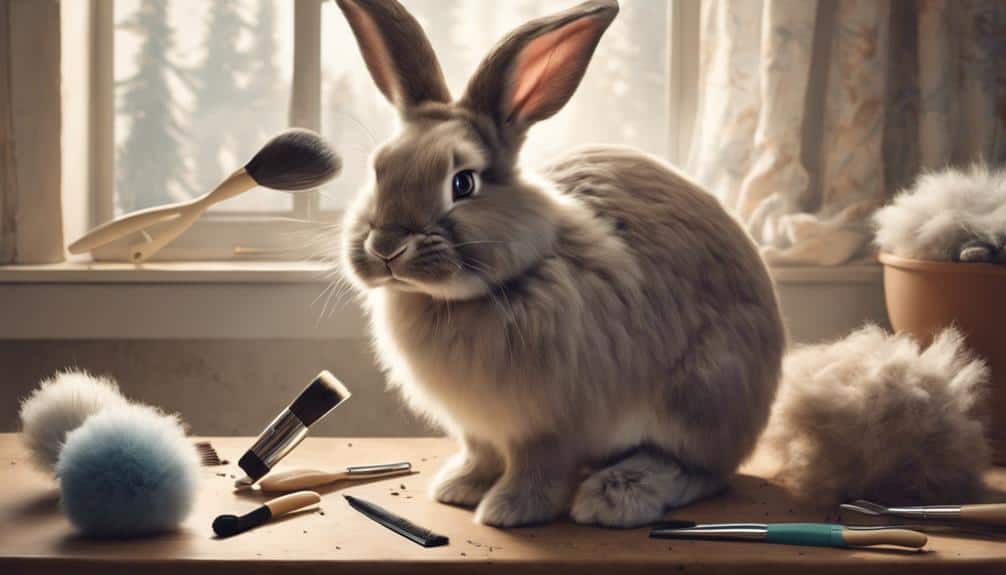
Dealing with abnormal shedding in rabbits necessitates prompt veterinary attention to address potential health issues such as skin infections, parasites, or underlying illnesses. When a rabbit experiences abnormal shedding, it may exhibit symptoms like appetite loss, increased scratching, or skin abnormalities. Consulting a veterinarian is essential for a proper diagnosis and treatment plan.
Skin infections or parasites causing hair loss should be treated promptly to prevent further complications. Addressing underlying health conditions promptly not only helps reduce shedding but also improves the overall well-being of the rabbit. A veterinarian can recommend appropriate treatments based on the specific health issue identified.
Hairball Prevention for Bunnies
To prevent hairballs in bunnies, maintaining a regular grooming routine and providing a balanced diet are essential practices. Here are four key steps to help prevent hairball issues in your beloved bunny:
- Grooming: Brush your bunny daily to remove loose fur and prevent excessive ingestion during grooming. This helps reduce the amount of hair your rabbit swallows, decreasing the risk of hairball formation.
- Diet: Make sure your bunny's diet includes plenty of hay, as it aids in digestion and prevents hairball buildup. Additionally, provide fresh water at all times to keep your rabbit hydrated, promoting healthy digestion and reducing the likelihood of hairballs.
- Monitoring Droppings: Regularly check your bunny's droppings for any changes in size, shape, or consistency, as these can indicate potential hairball issues. Immediate veterinary attention is crucial if you notice any abnormal signs.
- Veterinary Consultation: If you observe symptoms like decreased appetite, lethargy, or excessive grooming, consult a veterinarian promptly. Early detection and intervention can prevent serious complications associated with hairballs in bunnies.
Grooming Tips for Shedding Bunnies
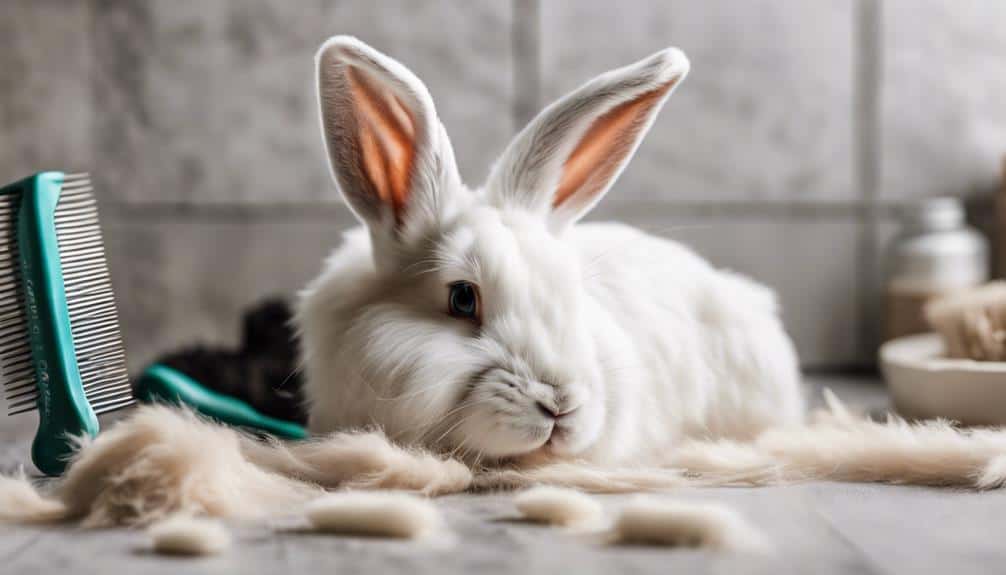
To effectively manage shedding in your bunny, proper grooming techniques are key for maintaining a healthy coat and minimizing fur-related issues. Regular brushing plays a vital role in controlling fur loss in shedding bunnies while promoting a shiny and healthy coat.
During shedding season, increased brushing sessions can help bunnies efficiently get rid of excess fur. Utilizing grooming tools such as flea combs and rubber brushes can assist in managing the shedding process effectively. For sensitive bunnies, consider gentle petting and plucking to aid in removing loose fur.
It's essential to choose the right grooming tools based on your bunny's fur type and skin sensitivity to guarantee a comfortable grooming experience. By incorporating these grooming tips into your routine, you can help your shedding bunnies maintain a healthy coat and reduce the impact of shedding on their overall well-being.
Maintaining a Clean Environment During Shedding
During shedding season, maintaining a clean environment for your bunny is essential to minimize fur buildup and promote a hygienic living space. Here are some effective ways to keep your bunny's surroundings tidy during shedding:
- Vacuum and Clean Regularly: Make it a habit to vacuum your rabbit's living area frequently to remove loose fur that can accumulate on floors and carpets.
- Utilize Lint Rollers or Damp Cloths: Use lint rollers or damp cloths to pick up loose fur from furniture and carpets where your bunny may have left some behind.
- Wash Bedding Frequently: Wash your rabbit's bedding regularly to prevent fur buildup and maintain a clean environment for your furry friend.
- Use Mats or Towels: Consider placing a mat or towel under your rabbit's favorite grooming spot to catch loose fur, making cleanup easier and preventing fur from spreading around.
Frequently Asked Questions
How Do You Take Care of a Rabbit's Fur Shedding?
To care for a rabbit's fur shedding, establish a grooming routine during shedding season. Use proper brushing technique, noting shedding patterns. Manage fur care by addressing shedding frequency, diet impact, and shedding process. Implement preventive measures for shedding management.
What to Do When Your Rabbit Is Molting?
When your rabbit is molting, stay attentive to their shedding schedule. Use proper grooming techniques and adjust their diet to support healthy fur growth. Monitor shedding patterns, consider environmental factors, and consult a vet for health concerns.
Why Is My Indoor Rabbit Shedding so Much?
You can manage your indoor rabbit's excessive shedding by establishing a regular grooming routine. Make sure your bunny has a stimulating environment to reduce stress factors. Keep an eye on their diet and health concerns to prevent shedding issues.
How Do You Keep Rabbits in a Shed?
To keep rabbits in a shed, guarantee proper ventilation, insulation, and lighting. Use suitable flooring like wood shavings or straw for comfort. Maintain a predator-proof structure, clean regularly, and provide ample space for play and natural behaviors.
What Causes Bunnies to Shed and How Can I Care for Them During Shedding Season?
Bunny shedding care tips are essential for helping your pet through shedding season. Bunnies shed to make way for new fur, so regular grooming is crucial. Brush your bunny gently to remove loose fur and prevent matting. Provide a healthy diet and plenty of water to support their health during this time.
Conclusion
To summarize, shedding is a natural process for bunnies that helps them adapt to changing temperatures. By properly grooming your rabbit during shedding season, you can help them lose their fur faster and prevent health issues like hairballs.
Remember, shedding can't be stopped, but with regular brushing and a clean environment, you can make the process more manageable. So, next time you see your bunny shedding, ask yourself, 'Are you taking the best care of your furry friend?'

